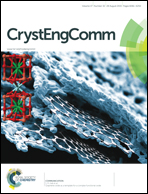1,4-Bis(imidazole)butane ligand and strontium(ii) directed 1-D chains based on basket-type molybdophosphates and transition metal (TM) linkers†
Abstract
Five unclassical heteropoly blues, (H2bib)3[{TMII(H2O)2}{Sr⊂P6Mo2VMo16VIO73}]·nH2O (TM = Fe (1), Co (2), Ni (3), Cu (4), Zn (5)); bib = 1,4-bis(imidazole)butane), have been hydrothermally synthesized and fully characterized. Compounds 1–5 are based on the basket-shaped [Sr⊂P6Mo2VMo16VIO73]8− (abbreviated as {P6Mo18O73}) units, which consist of a vacant Dawson-type “basket body” {P2Mo14} unit and a “handle”-like {P4Mo4} fragment encasing a Sr2+ cation in the central cage. All the compounds exhibit isostructural 1-D zigzag chains linked by a {TM(H2O)2} unit, which are observed for the first time as 1-D basket-like assemblies connected by a TM linker. The optical band gaps of 1–5 show that they are semiconductor materials and potential photocatalysts. Compound 2 as a representative catalyst exhibits a universal highly efficient degradation ability for typical dyes MB, MO, and RhB under UV light and bifunctional electrocatalytic behavior for oxidation of AA and reduction of NO2−.


 Please wait while we load your content...
Please wait while we load your content...